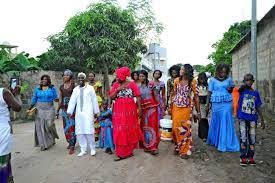Gender Roles In Africa.Gender and the Hierarchy of Work for women in africa.The lot of rural women has always been hard. Whatever the ecology of the region or its dominant religion, animist or Muslim, rural society had the same broad outlines almost everywhere.

The basis of agrarian social organization was gender division of labor—assigning to men labors requiring strength, such as warfare, the building and rebuilding of houses and cellars (except among the Tswana), hunting and fishing (but among the Bete of Cote d’Ivoire, fishing was a subsistence activity of women only), and politics16 and to women subsistence activity and child rearing. Women had many obligations but also a few prerogatives and a certain autonomy. Most of the time they worked, ate, and amused themselves in a group. Women and young children lived apart from the world of men, who worked and ate meals prepared for t.hem by the women separately.
Gender Roles In Africa,How Tasks are divided between Men And Women In Africa.
Organization by gender was visible not only in the way in which tasks were divided but in the standards according to which each sex was evaluated and evaluated itself. A woman’s value and status depended first on her fertility and second on her cooperativeness, initiative, and ability to work. A man was judged in terms of his courage and even capacity for aggression, his ability with words, and his physical prowess. The major distinction was that men made the rules whereas women had power only over themselves. Conversation between men and women was rare, and polygamy did not encourage it. The couple’s relationship consisted mainly of spending the night together and intercourse. Male supremacy was omnipresent, even in matrilineal societies, where transmission of the family’s line and goods was by women but not for women.
Matrimonial theory and practice did not alter women’s everyday tasks. At best they helped balance the division of responsibilities between the sexes and created more hierarchy within the community of women. Older women, the husband’s mother in particular, gained particular authority because of their role in transmission. Their power was recognized when they reached menopause, which excluded them from the reproductive cycle. They exerted this power over their daughters-in-law, their younger co-wives, and, of course, slave women, who might also be co-wives. The result was that older women reproduced, within the community of women, the same hierarchical relations that governed relationships between elders and their many dependents—younger people, women, and slaves. They organized and supervised work done mainly by younger people and servant women. In essence, this was work done in then stead and not for them but for the lineage head. This form of organization occurred at all levels, from the basic family unit to the state.
Gender and the Hierarchy of Work for women in Africa.;Gender Roles In Africa
In hierarchical societies, where a political structure including an aristocracy coexisted with a kinship system, things were more complex. Here women’s economic roles varied with their husbands’ social positions. Some aristocratic women worked little or not at all. Early in this century, the Germans suggested to the Bamum King Njoya that he should make use of his wives. He responded by having them make weavings to supply the shop he had opened, but they continued to depend materially upon him.17 The main task of women of the aristocracy, like that of older women in purely kinship-based societies, was supervising the w’ork of their dependents and slaves. In central Africa’s aristocratic societies of Rwanda and Burundi, where a ruling class of herding Tutsi dominated a lower class of Hutu farmers, Tutsi noblewomen supervised the Hutu’s work, and Hutu women worked hard at agricultural subsistence while the labor of their husbands in their fields or at war was monopolized by the aristocracy. Yet a Hutu man, despite his miserable position, remained no less a patriarch within his own family, where his wife had to kneel to offer him beer.1*
Another extreme example was the state of Garenganze, which was organized at the end of the nineteenth century in Katanga (today Shaba, in southern Zaire) by a Nyamwezi slave trader named Msiri. His state was composed of several autonomous groups among whom he had personal representatives—wives and other kin of both sexes. This allowed him to contract diplomatic marriages with various noblewomen from surrounding areas or between women of his family and local Yeke or Swahili chiefs under his authority.
These women gave him their loyalty and efficiency and became powerful civil servants. Beyond revenues from ivory and the slave trade, the state’s economy depended on tribute paid in foodstuffs. This ensured the subsistence of Msiri’s warriors and caravans, especially when they were staying in the capital. The capital was a group of forty-two villages with about 25,000 inhabitants. Msiri’s wives administered a vast semiurban complex with the authority he delegated them.
Large farms were cultivated by slave women, the main workforce. During critical periods in the agricultural cycle these women were joined by teams of men directly supervised by men. Thus the permanent inhabitants of the capital were mostly women. The frequent movements of caravans and warriors offered them much sexual opportunity, and the reported frequency of polygamy and divorce implies the relative emancipation of the dominant class of women.